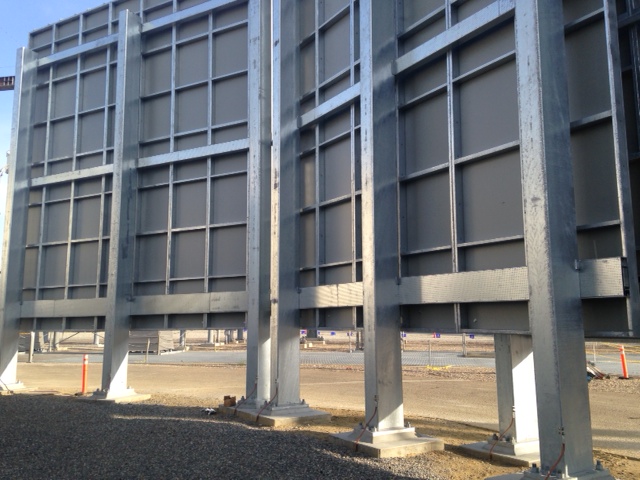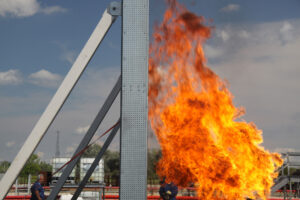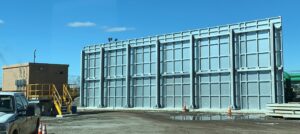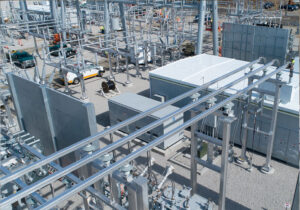Control buildings house critical systems like electrical controls, communication setups, mechanical equipment, and data centers. These buildings must be protected from ballistic threats, explosions, and fires. Without proper defense, operations can be disrupted, causing downtime and costly repairs.
Fire barrier construction is important for protecting control buildings against fire and blast risks. Barriers that guard against such threats safeguard valuable infrastructure and maintain the continued function of operations. Fire barrier construction is key to maintaining the safety of control buildings in industries where constant operation is critical.
Why Ballistic and Fire Protection Matter for Control Buildings
Vulnerability of Control Buildings to External Threats
Control buildings are key to keeping operations running smoothly. They house vital systems like electrical panels, communication equipment, and backup generators. These buildings face many threats, such as gunfire, explosions, and fires. Without protection, these threats can severely damage or destroy the infrastructure.
When the building is compromised, it can halt operations. This causes long delays, expensive repairs, and lost productivity. Ballistic and fire protection barriers act as shields, stopping external threats before they cause harm. They help maintain the safety and functionality of the control building, reducing downtime and keeping operations on track.
Impact of Ballistic and Fire Risks on Infrastructure
Ballistic and fire risks pose a major threat to control buildings. A fire or explosion can destroy vital equipment like electrical systems, communication networks, and mechanical tools. When these systems are damaged, operations are halted, leading to costly downtime. It can take weeks or even months to restore everything to working order.
This downtime not only affects the facility but can also disrupt the entire operation. Installing fire and ballistic barriers helps reduce these risks, keeping vital infrastructure intact and allowing operations to continue without major interruptions.
Types of Ballistic and Fire Barriers for Control Buildings
Fire-resistant Barriers for High-risk Areas
Fire-resistant barriers are designed to protect high-risk areas, such as electrical rooms and data centers, where fire hazards are a constant threat. These areas house equipment that is vital for operations and can be easily damaged by fire. The barriers are made from materials that can resist high temperatures, stopping fires from spreading quickly.
In case of fire, these barriers prevent flames from reaching sensitive equipment, limiting damage. They also reduce the time and cost required to repair or replace damaged infrastructure. Installing fire-resistant barriers in high-risk areas is an effective way to protect critical systems and keep operations running.
Ballistic-Resistant Materials in Protection
Ballistic-resistant materials are crucial for protecting control buildings from external attacks. These materials stop or deflect projectiles, including bullets or shrapnel, which could damage vital systems. Ballistic-resistant barriers are often installed around key areas, such as doors, windows, and walls, to safeguard equipment.
These materials are designed to absorb the force of impacts without allowing penetration. Using ballistic-resistant barriers helps reduce the risk of equipment damage during violent incidents, allowing the building to remain secure. By installing these materials, you can protect control systems and prevent costly repairs, keeping critical infrastructure safe from external threats.
How Barriers Protect Essential Control Systems
Protecting Electrical and Communication Systems
Electrical and communication systems are vital in control buildings. These systems help keep operations running and allow communication across different areas. Without protection, these systems can be damaged by gunfire, explosions, or fires. Ballistic and fire barriers provide defense against such threats.
These barriers shield sensitive electrical wiring and equipment, preventing costly damage. By using the right barriers, the electrical and communication systems remain intact, allowing operations to continue without disruption. Protecting these systems is a key step in maintaining the smooth flow of critical operations within the building.
Shielding Mechanical Equipment and Generators
Mechanical equipment, like backup generators, play an important role in keeping control buildings operational. These systems kick in when the main power supply is interrupted, making them crucial for uninterrupted operations.
Fire and ballistic barriers protect mechanical equipment from external threats such as explosions and fires. These barriers prevent damage to backup generators and mechanical systems, making sure they remain functional during emergencies.
Without proper protection, damage to these systems could cause significant delays, interrupting the flow of operations. Shielding mechanical equipment with proper barriers helps avoid these risks, keeping the building’s systems intact and operational.
Benefits of Investing in Ballistic and Fire Barriers
Reducing Damage and Service Interruptions
Ballistic and fire barriers help reduce damage from external threats. When a building is exposed to fire, explosions, or projectiles, it can suffer major damage. This leads to costly repairs and long service interruptions. Barriers act as a shield, stopping fires and projectiles from reaching sensitive systems.
This helps keep equipment intact and allows the building to remain operational. By investing in these barriers, you protect your infrastructure, reduce repair costs, and limit downtime. This means fewer delays in operations, helping maintain a steady workflow and avoiding costly disruptions.
Safety for Personnel and Surroundings
Barriers not only protect equipment but also safeguard the people inside the building. In the event of a fire, explosion, or attack, the barriers keep the danger away from staff and nearby areas. These protective measures create safe zones within the building, allowing personnel to remain unharmed.
Ballistic and fire barriers also help keep dangerous smoke, flames, or shrapnel from spreading to surrounding areas. This reduces the risk of injury or harm to employees and minimizes the danger to the environment. With the right protection in place, personnel and their surroundings are better shielded from potential hazards.
Choosing the Right Ballistic and Fire Protection for Your Facility
Identifying Your Facility’s Protection Needs
Each facility has unique needs when it comes to protection. The type of equipment, the building’s layout, and the risk factors all play a role in determining the best barriers. Some areas may be more vulnerable to fire, while others may need protection against ballistic threats.
Understanding your facility’s needs is the first step in selecting the right barriers. A thorough assessment of your building helps you pinpoint areas of high risk. By identifying these needs, you can choose barriers that are most effective in safeguarding your infrastructure and keeping operations running smoothly.
Professional Installation of Barriers
Installing ballistic and fire barriers requires more than just placing them in the right spots. Professional installation is key to making sure the barriers work as they should. A team with the right experience installs the barriers correctly and complies with safety standards.
They will also assess the building to determine the most vulnerable areas and where protection is needed most. Proper installation allows the barriers to offer maximum protection. Working with trained professionals helps make sure your facility stays safe from external threats and that the installation process is efficient and reliable.
Protect Your Facility with Sinisi Solutions
Every control building has its own set of risks and protection needs. By investing in ballistic and fire barriers, you protect the most critical components of your infrastructure. Sinisi Solutions works with you to assess risks and install the right defenses to maintain smooth, continuous operations. Our tailored solutions are designed to meet the specific needs of each facility. Don’t wait for an incident to disrupt your operations. Secure your facility with our reliable protection systems. Visit us at75 Main Street, Manasquan, New Jersey, 08736.




